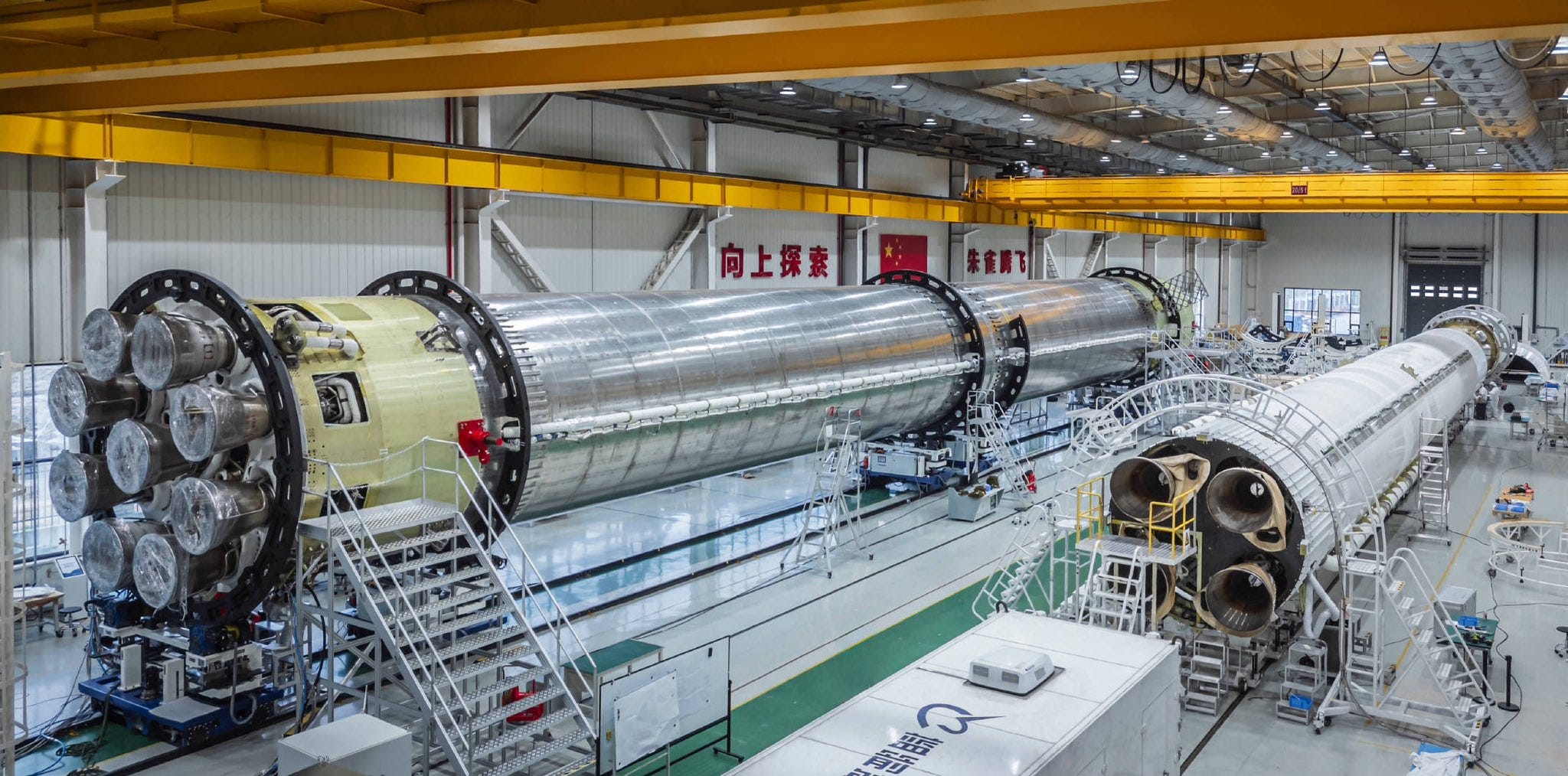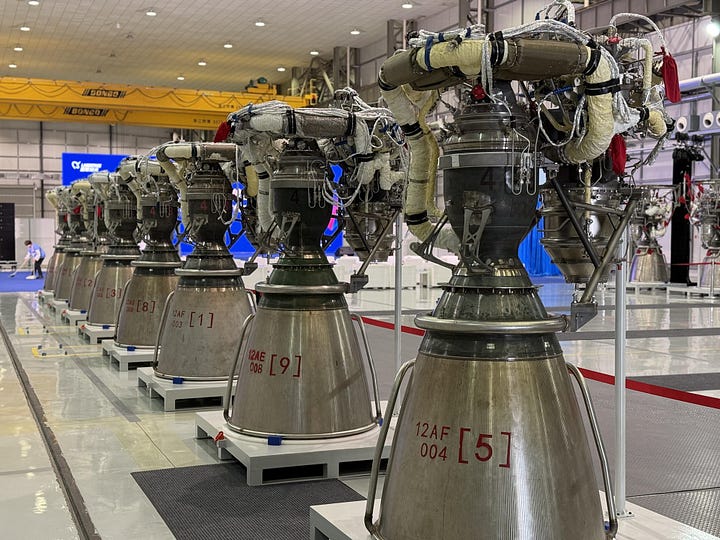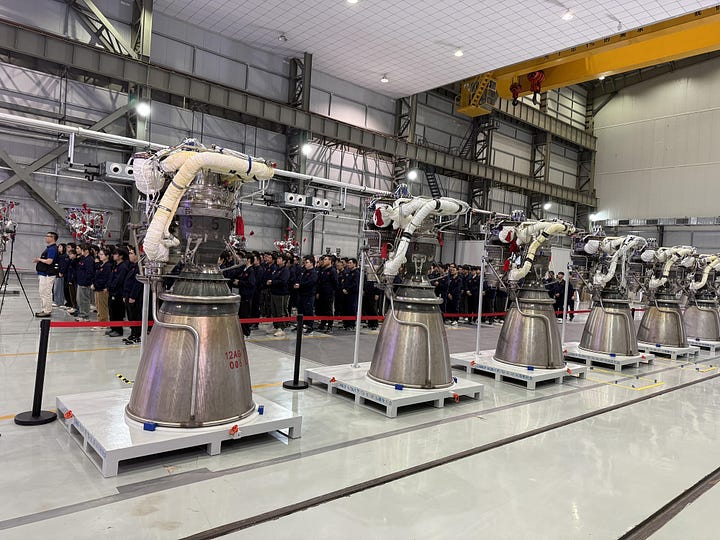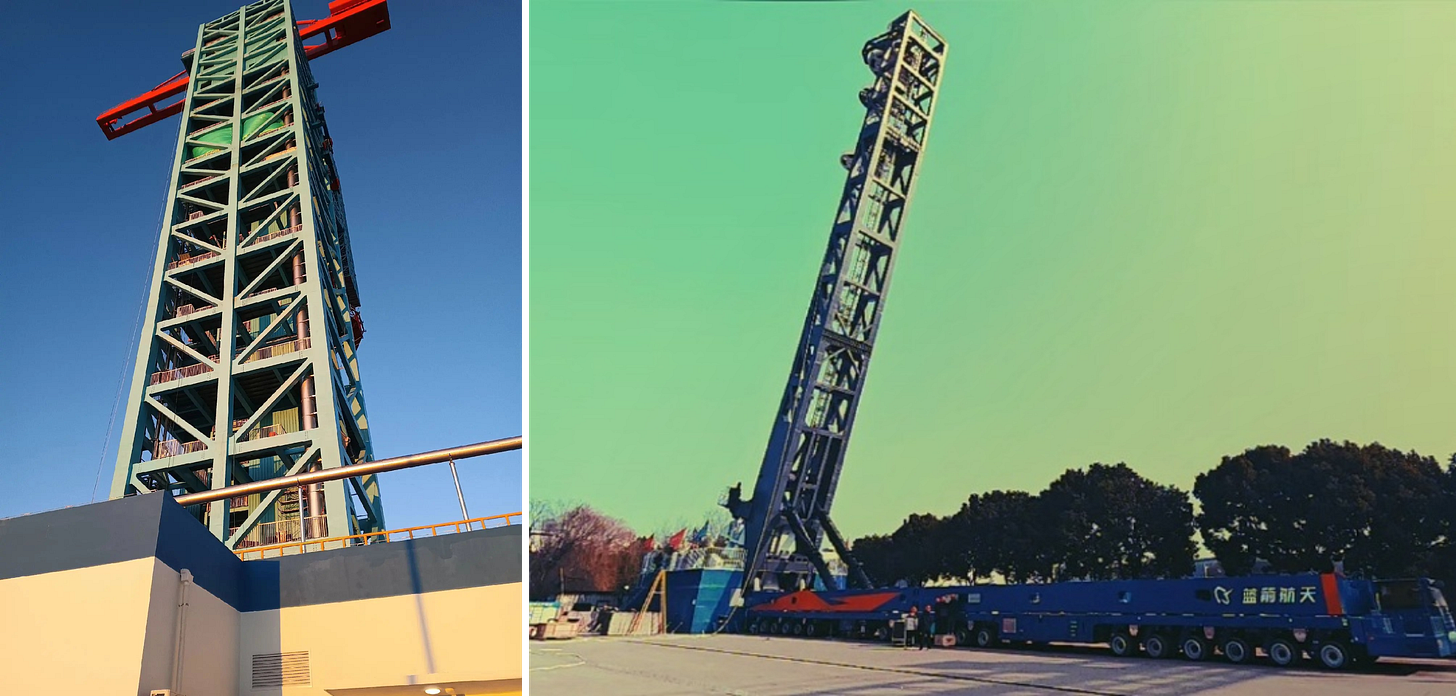LandSpace Moves Toward First Flight of Its Reusable Rocket
Major tests of the Zhuque-3 reusable launch vehicle could occur soon.

Earlier today, April 15th, CCTV13 aired a report from LandSpace’s engine manufacturing facility in Huzhou (湖州市), Zhejiang Province (浙江). The report shared various useful updates ahead of Zhuque-3’s debut flight, set to take place as soon as July.
To begin, LandSpace’s engineers informed the reporter that the Zhuque-3 Y1 launch vehicle has completed assembly at the company’s rocket manufacturing facility in Jiaxing (嘉兴市), also in Zhejiang. Major ground testing and flight verification tests are expected to be performed on the completed first and second stages soon. The stages may have recently received their engines too, ahead of static fires.
Additionally, it was stated that the one-hundredth Tianque (TQ) engine, which burns liquid methane and liquid oxygen, had rolled off of LandSpace’s production line. Details about the variant of the engine were not shared, meaning the company could have a few dozen flights worth of engines ready. The following images of over a dozen completed engines was however.


Furthermore, the report shared that 3D printing technologies, like additive manufacturing, have been integrated into engine production. Advantages of including 3D printing include reduced material waste, shorter production timescales, and automation, all lowering costs. Components made using 3D printing in the Tianque engines include various propellant pipes, manifolds, and structural supports.
Alongside the CCTV13 report, an image of the three major variants of the Tianque line of engines was shared. Each major variant is believed to have the following performance: TQ-12, used on Zhuque-2 and Zhuque-2E, with 67 tons of thrust; TQ-12A, expected to fly on initial Zhuque-3’s, with 81.5 tons of thrust; and TQ-12B, expected to fly on later Zhuque-3’s, with 100 tons of thrust. The TQ-12B is currently LandSpace’s end goal with the first-stage engine, and has performed 550 seconds off test firings so far.
With hardware appearing to move quickly into place for flight, a static fire of the first-stage may not be that far away. LandSpace is yet to announce shipping Zhuque-3’s first and second stages to its launch pad at the Jiuquan Satellite Launch Center, where a nine-engine static fire is most likely to occur. But if the vehicle’s first-stage has its engines, as leaks suggest, transport to Jiuquan is possibly not far away. Zhuque-3’s launch pad could have been completed since late January too.
Aspirationally, three missions with Zhuque-3 may occur this year. The vehicle could also land a first-stage this year as well, with the company head telling China Daily the following:
"These launches will deliver a combined payload capacity of around 60 tons, and we are targeting the successful recovery of the rocket's first stage within these three missions"
For the debut flight itself, Zhuque-3 could fly in a configuration unable to lift 21,300 kilograms. Instead, the first few vehicles may be limited to lifting no more than 11,800 kilograms when expended or 8,000 kilograms with a downrange landing, according to a leaked customer guide. Instead, the first few vehicles may be limited to lifting no more than 11,800 kilograms when expended or 8,000 kilograms with a downrange landing.
The first handful of vehicles may also be shorter, by around ten meters, and almost 100,000 kilograms lighter while using the less powerful TQ-12A engines for the first-stage and the TQ-15A engine for the second-stage. As such only downrange landings may be possible until the vehicle is upgraded in later missions, to use the TQ-12B.
CCTV13’s report is attached below, via a copy uploaded to YouTube.
For those who cannot understand Chinese, here is a transcript of the report:
“Welcome, everyone, from the development base of the Zhuque-3 propulsion system located in Huzhou, Zhejiang. So what does Zhuque-3 actually look like? Take a look, right next to me is a 1:24-scale model of Zhuque-3. With its sleek, silver-white structure and tall, elegant profile, it might look slim, but don’t be fooled by its slender appearance, its liftoff thrust can reach 900 tons.”
“In the second half of this year, Zhuque-3 is expected to make its maiden flight, potentially becoming China’s first reusable launch vehicle. So what exactly does “reusable rocket” mean? Simply put, after the rocket completes its satellite launch mission, it can reverse course and return to Earth, landing steadily. Engineers just need to carry out some basic repairs and modifications, and it can be ready for the next launch.”
“This approach significantly reduces costs. As we know, launching rockets is extremely expensive. If rockets can be reused, the cost per launch could drop by around seventy percent. Such cost reductions would help China deploy satellites faster and more frequently.”
“Everyday technologies like communication and navigation are closely linked to satellites. For ordinary people, this could mean that one day, we’ll have full internet coverage anywhere in the world, more precise car navigation, and more accurate typhoon tracking.”
“Engineers told me that the Zhuque-3 vehicle has already completed full assembly in Jiaxing, Zhejiang, and has officially entered the critical phase of ground testing and flight verification. Right now on site, we can see engineers assembling engines from the same Tianque series used on Zhuque-3.”
“Today marks a significant milestone for the Tianque engine series as well, its 100th engine has just rolled off the production line. This symbolizes that China’s commercial aerospace propulsion systems have now entered the stage of scaled application. In other words, they can provide a continuous and reliable “heart” for rocket launches. This is a milestone for the high-quality, large-scale development of China’s commercial space industry.”
“In recent years, engineers have been applying 3D printing technology in engine production. For example, the components displayed on the table here were all made using 3D printing. Traditional engine manufacturing is like hand-carving ivory—requiring cutting, grinding, welding, and assembling hundreds of parts, with a relatively high risk of failure. But with 3D printing, component reliability improves, material usage is reduced, and production times are shortened.”
“We’ve learned that there are now over forty upstream and downstream companies in the aerospace industry chain in Huzhou, Zhejiang, vigorously developing the aerospace economy. This area is now on a brand-new track for high-quality growth.”
If there are any problems with this translation please reach out and correct me.
Prior progress
Back in September 2024, LandSpace performed its second hop test with its Zhuque-3 VTVL-1 (vertical takeoff vertical landing) test vehicle, flying to an altitude of around 10 kilometers. It followed a low-altitude test from January of that year, which flew to around 350 meters up. Both tests were flying successes, with the second demonstrating an in-flight engine restart ahead of landing.
In the second test, four grid fins and various reaction control thrusters guided the test vehicle up until the engine relighte. Powered descent then brought the vehicle down to its landing pad, where it landed 1.7 meters off-center at a speed of 1.65 meters per second, or 3.7 miles per hour (5.95 kilometers per hour). Following the landing, LandSpace boasted:
“This mission is the first time in China to achieve technical verification such as the secondary ignition of vertical take-off and landing return rockets in the air,” — “China's commercial aerospace has made a major breakthrough in reusable launch vehicle technology, for the future to achieve large capacity, low cost, high frequency, reusable space launch has taken a key step!”
As mentioned earlier on, Zhuque-3’s launch pad at the Jiuquan Satellite Launch Center appears to be complete. The rocket’s launch tower currently had a crane installed to stack the second-stage and fairing, including payload inside, an arm for providing consumables and propellants, as well as various access platforms for the upper parts of the rocket, all featured on company renders.
For bringing the first-stage to and from the launch pad, a transporter-erector as been built and tested too. Zhuque-3’s transporter-erector is quite short compared to similar systems, from Space Pioneer and SpaceX, and will likely be used just to transport the rockets first-stage, unless it is extended. It may also not remain at the launch pad during launch attempts.
Future plans
If LandSpace’s plans for 2025 are successful, in 2026 Zhuque-3 will aim for twelve launches, possibly for one flight a month. Eventually, LandSpace wants to perform one Zhuque-3 launch per week.
Looking further along, LandSpace Chief Executive Officer and Founder Zhang Changwu (张昌武) is confident that within three years of Zhuque-3’s debut mission, it will lower costs to 30,000 Renminbi (4,100 United States Dollars) per kilogram, allowing launches to cost 549 million Renminbi (75.18 million United States Dollars), assuming first-stage downrange landings. In the future, Zhang hopes that they can reduce the cost further to 3,000 Renminbi (410 United States Dollars) per kilogram, for a launch cost of 54.9 million Renminbi (7.5 million United States Dollars).
What is Zhuque-3?
Zhuque-3 is LandSpace's in-development two-stage partially reusable medium to heavy lift launch vehicle. Zhuque-3 plans to burn liquid methane and liquid oxygen propellants in its engines on both stages, which will be built out of stainless steel.
LandSpace claims that Zhuque-3 will be able to lift up to 21,300 kilograms to low Earth orbit when expended, 18,300 kilograms when landing downrange on a drone ship or landing pad, or 12,500 kilograms when returning to the launch site.
The first-stage of Zhuque-3 is planned to be powered by nine TQ-12A engines, later swapping the TQ-12B engines, generating an approximate combined 900 tons of thrust while burning liquid methane and liquid oxygen. LandSpace is also looking to fly each first-stage twenty times, with the potential to certify them for more flights.
The second-stage of Zhuque-3 is planned to be powered by one TQ-15B generating a believed 100 tons of thrust while also burning liquid methane and liquid oxygen.
To facilitate reuse of the first-stage, three engines will be lit during re-entry followed by one being lit again for landing on a drone ship or landing pad. For boost-back burns, the booster will turn around in-flight after separation and relight one engine.
The boosters and second stage are currently planned to have a diameter of 4.5 meters. The fairing is planned to be 5.2 meters in diameter and split into two halves. The total height of Zhuque-3 is currently planned to be 76.6 meters with it having a fully fuelled mass of approximately 660,000 kilograms.







